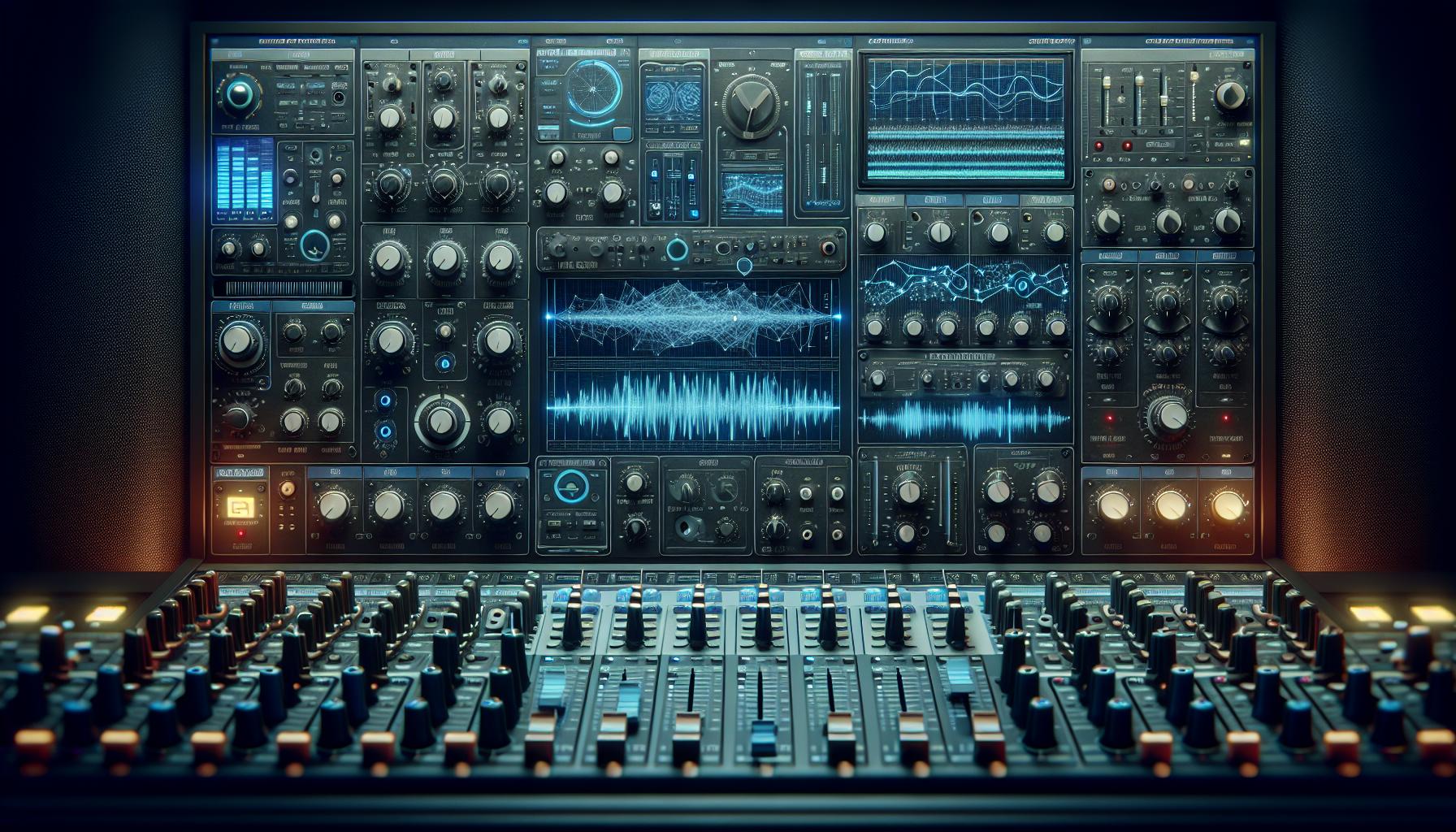In my years as a music producer, I’ve discovered that effects are the spice of any good track. They’re what transform a simple melody into a captivating soundscape. But it’s not just about slapping on reverb or delay; it’s about using these tools creatively to enhance the listening experience.
You see, a well-placed effect can be the difference between a good song and a great one. It’s all about understanding how to manipulate sound to create a unique sonic identity.
Whether you’re a seasoned producer or just starting out, I’m here to guide you through the creative use of effects in music production. Let’s dive in and explore the magic of music production effects together.
Contents
Understanding the Basics of Music Production Effects
Now that we’ve discussed the relevance of effects in music production, let’s delve into their basic principles. Effects are crucial tools that, if used with care and creativity, can take your music to new sonic heights. However, it’s important to understand that effects are not a band-aid solution for poor melodies or song structures. They’re tools to enhance and experiment, not fix fundamental flaws.
Reverb and delay – two vital effects in any producer’s arsenal. Both effects play with the element of time in a piece of music. Reverb, or reverberation, creates a sense of space or environment around your sound. Think about the echo you hear when you shout in a massive, empty room— that’s reverb. On the other hand, delay repeats sound sequences in distinct time intervals, allowing you to create complex soundscapes.
Compression plays a big part in shaping your sound. It helps to balance the dynamics within a track, making the quiet parts louder and the loud parts quieter. If you’ve ever wondered how professional tracks maintain such consistent volumes, compression is the answer.
In addition, EQ (Equalization) is an essential tool in audio processing. It’s an effect that adjusts the balance of frequency content within the audio signal. Essentially, EQ lets you increase or decrease volumes at specific frequency ranges; helping to sculpt and define the sound.
The key to mastering these basics, and any effect, lies within mindful experimentation and practice. After all, your unique use of these tools will ultimately define your sonic identity, while staying within traditional production standards.
Music production effects are multifaceted tools; they can act as a stylistic device, a corrective tool, and even a transformative agent. Understanding their function and potentials isn’t just about comprehending the technology behind it, but recognizing the artistry it affords us to create soundscapes like never before.
The Role of Effects in Creating a Unique Sound

The role of effects is often undervalued when it comes to creating a unique sound. But, the truth is that they are extremely important. They allow for fine-tuning individual tracks and help to add depth to the overall mix. There’s so much you can achieve with the right layer of reverb or a timely delay. It’s all about mastering the subtleties of these effects.
Now you might wonder, how exactly can you make your sound unique with these tools? The secret lies in intricate experimentation. Don’t think about these effects as just simple add-ons. They’re much more than that. They provide you an opportunity to shape your tracks in a way you want them to be heard.
Let’s talk a bit more about reverb and delay. A song without reverb isn’t just dry but also lacks a sense of space and vibe. It’s the magic of reverb that gives a song its room and depth. Similarly, delay can be used to create rhythmic patterns, add thickness or simply to precisely craft a vibe that fits the track. But, the key here is to use them judiciously to ensure their presence doesn’t overshadow the main element of the track, the melody.
So, the trick here isn’t to just thrown in a bunch of effects, but rather to apply them thoughtfully. That’s why I emphasize the importance of knowing your tools inside out. It’s not just about twisting knobs and pushing faders, it’s about understanding the essence of each effect and using it to your advantage in enhancing your music.
The use of effects has moved beyond just being corrective tools. They’ve become an integral part of the creative process, allowing artists to create unique soundscapes that define their sonic identity. Remember, your music should be like your fingerprint – unique and identifiable. With proper understanding and creative use of effects, you’re well on your way there.
In the end, it’s all about practice. The better you understand your tools, the better you can express your musical thoughts. So, keep experimenting, keep learning, and one day, you’ll find your own unique sound.
Selecting the Right Effects for Your Track

When producing a track, it’s crucial to understand that not all effects are suitable for every song. Choosing the right effects is a creative process that requires a deep understanding of both the music and the tools at hand.
Consider the Genre
Before diving headfirst into the sea of effects, it’s imperative to consider the genre you’re working in. Different genres have different “rules” when it comes to effects. For instance, a thick, heavy reverb might be well received in a dream-pop track but would likely dampen the punchy vibe of a techno one. Once you’ve pinpointed your genre, you’ll have a jumping-off point for selecting effects.
Listen to the Song
Really listen to your song. What is it asking for? What could enhance its uniqueness? Is it craving reverb, delay, or perhaps some distortion? As you familiarize yourself with the feel of the track, you’ll start to hear opportunities for effects that can accentuate and enhance its innate character.
Experiment, Experiment, Experiment
Once you have an idea, the adventure of experimentation begins—this is where the majority of your time might be spent when dealing with effects. Don’t be afraid to try out different effects on various sections of your track. By tweaking settings and critically listening to the results, you’ll start to discover what works well for your music.
Use Effects Sparingly
Remember, less is often more. You don’t want to lose the soul of your song in a haze of excessive processing. Use effects to emphasize and enhance, not dominate, your track. Be patient, be discerning, and most importantly, trust your ears. Your unique sonic identity doesn’t come from copying what everyone else is doing—it’s about finding the sounds and effects that resonate with you and your music.
Creative Techniques for Using Effects in Music Production

When it comes to the creative use of effects in music production, there’s an entire universe of techniques waiting to be explored. Remember, don’t be afraid to experiment! The key is to understand the tools at your disposal and how to harness them to express your unique artistic vision.
Layering effects is one technique that can lead to truly unique results. You’re not limited to using just one effect per track; in fact, using multiple effects can often lead to a more full and detailed sound. It’s important, though, not to go overboard – too many effects can make your music sound cluttered and incoherent.
Another technique I’ve found useful is automating effects. This involves modifying the parameters of effects over time, creating an evolving sound that can add a great deal of depth and dynamism to a track. For instance, automating a delay effect can create an echo that increases in intensity, adding tension and anticipation to a key part of your song.
Sidechain compression is another powerful tool in a music producer’s arsenal. Historically associated with dance music, sidechain compression can be used in virtually any genre to create rhythmic pulsations that give a track drive and momentum. By minding the genre, tempo, and mood of your track, you can bring out an entirely new dimension to your music.
Don’t forget about reverse reverb, too, a technique that can give your music a mysterious and ethereal quality. This involves reversing a track, applying reverb, and then reversing it again, resulting in a crescendo effect that can work particularly well for emphasizing a key moment or transition in your track.
As you delve deeper into the world of music production effects, you’ll discover many more techniques to experiment with. Always trust your ears, stay open to new ideas, and remember this fundamental truth: The only limit to your creativity is your imagination.
Case Studies: Examples of Creative Effect Usage

Looking into case studies, there’s quite a great deal of inspiration that one can pull from various artists and producers. They often find innovative ways to apply effects that you and I can learn from.
Renowned producer Brian Eno is a prime example. He is known for his pioneering work in ambient music and his innovative use of effects. Eno, without a doubt, mastered the art of stretching the limits of music production effects. In his track “1/1” from the album “Music for Airports”, Eno layered several tape loops of different lengths, creating an ever-changing soundscape. This unique way of layering effects, using different lengths resulted in creating a sonic landscape that feels both alive and compelling.
Another intriguing case involves Portishead, an English band known for their use of tape saturation. Their use of analog gear and tape saturation creates a nostalgic, vintage feel in their music. When you listen to tracks like “Roads” or “Mysterons” from the album “Dummy”, you’ll notice the warm, gritty sound that has become their trademark.
Imogen Heap provides yet another inspiring example. She’s known for her innovative looping and vocal manipulation techniques. In her track “Hide and Seek”, Heap used a vocoder to manipulate her vocals, giving them an ethereal, otherworldly feel. That’s an excellent demonstration of how automating effects can lead to new creative frontiers.
And who can forget the magic of Radiohead? Their track “Idioteque” showcases the brilliant use of sidechain compression, creating a pulsing rhythm that drives the entire track.
These artists and their innovative use of effects serve as a wellspring of inspiration. They encourage music producers and artists like us to push beyond the traditional boundaries of music production effects, exercising our imaginations, sparking new ideas and ways to express our artistic visions. Each exploration into the creative realm of effect usage, each success, and even failures open a myriad of possibilities. Every step deepens our understanding, inspiring us to experiment and create our own unique sonic worlds.
Experimenting with Unconventional Effects
Now that we’ve drawn inspiration from inventive producers like Brian Eno, Portishead, Imogen Heap, and Radiohead, let’s dive into the intriguing realm of unconventional effects. When it comes to audio effects, the sky’s the limit. These tools can drastically reshape your sound and lead you to unexplored sonic avenues.
With DAWs (Digital Audio Workstations) and a broad spectrum of plugins available today, we’re not constrained to traditional effects likes Reverb, Delay or EQ. Think outside the box, get hands-on with Granular Synthesis, Reverse Reverb, Drones or Stochastic Resonance. The key here is to experiment with these “outlandish” effects and not to fear the unknown. My motto’s always been – “Create art, break rules!”
Take Granular Synthesis, for example. It manipulates sound by dividing it into minute particles or “grains.” This technique’s used by artists like Radiohead and Aphex Twin for their unique mind-bending tracks. By tweaking the parameters like grain size, spread, and pitch you can warp, stretch, and mangle your audio to create something entirely fresh.
Then there’s the Reverse Reverb or “preverb,” which produces surreal swooshing or ghostly echoes. It’s quite popular in genres like psychedelic rock and dream pop. The 80’s band, Cocteau Twins famously used it to mystify their vocals, resulting in a distinguishable ethereal ambience.
And if you’re in the mood for producing some avant-garde, drone music, Stochastic Resonance should be your pick. This effect introduces random noise into your music and is favored by experimental artists for creating ambient soundscapes.
Enhancing the Listening Experience with Spacial Effects
If you have been tinkering with effects, you know that spatial effects can dramatically change your track’s ambiance, lending an immersive quality that genuinely enhances the listener’s experience.
In this realm of production, tools like reverb, delay, and panning can add dimensionality to your compositions. Reverb, for instance, can recreate the acoustics of different environments. From the intense echo of a cathedral to the subtle resonance of a small room, it can transport your listener, sonically, to anywhere in the world—or beyond!
Stereo imaging, another crucial spatial effect, enables the mixing of a track in a way that it appears to come from various directions. By adjusting the audio’s left and right channels, you can create the illusion of depth and space. In essence, you make your sound become three-dimensional.
Let’s take it up a notch and talk about more advanced spatial effects. Have you heard of psychoacoustic panning? Psychoacoustic panning, a more complex form of stereo imaging, simulates depth and space using phase and frequency differences. This means you can literally manipulate the listener’s brain to perceive sounds as if they’re coming from behind, above, or below.
Even more dynamically, spatial effects can be automated. This allows a sound to move dynamically within a mix, creating a sonic landscape that changes over time. Imagine a synth line that begins in the far distance, gradually drawing closer, until it surrounds the listener before retreating away again. It’s not just about creating a mix that sounds good, but a mix that tells a story and engages the listener.
In my experience, the creative use of spatial effects can significantly elevate the quality of a track. They allow the artist to craft a soundscape that is not merely heard but actively experienced. And who knows? By experimenting with spatial effects, a world of mind-bending tracks awaits you.
Exploring Advanced Effect Processing

Delving deeper into the rabbit hole of effect processing, advanced techniques often take advantage of a profound understanding of signal routing, modulation, and synthesis. You’ll find that pushing beyond simple delay, reverb, and panning can open up realms of sonic manipulation that were previously uncharted. It’s important to remember: experimentation is key.
Multi-effect processing is the technique of chaining numerous effects together, often leading to incredibly complex and unique sounds. Many DAWs provide built-in multi-effects plugins, with frequent update support. Notable examples include Ableton’s Effect Racks and Logic’s Smart Controls. With these plugins, you could easily craft an atmosphere distinct to your track by processing multiple effect units concurrently.
Let’s talk about modulation-based effects. They manipulate the time, pitch, or amplitude of a sound to create sweeping, dynamic changes. Modulation effects, such as chorus, flanger, and phaser, can provide your mixes with the organic movement they need to be engaging.
And let’s not forget about frequency and amplitude modulation. These systems allow for incredibly detailed sound design and can be seen frequently in genres focused on timbral innovation. Some renowned instances include electronic genres such as dubstep, drum and bass, and techno.
Moving to Granular Synthesis. This process involves taking tiny slices of sound samples, or ‘grains,’ and manipulating them to create entirely new sounds. The potential for experimental soundscaping is immense, with granular synthesis responsible for some of the most ground-breaking sound design in contemporary music.
Continuing down this innovative path, we find subtractive synthesis. It works on the principle of removing certain frequencies from a source signal to shape the sound. This method was crucial in the dawn of analog synths and remains relevant today – in both hardware and software synth designs.
The utilization of additive synthesis is also worth discussing. This technique involves combining sine waves – the most basic form of a sound wave – to generate complex waveforms. It lends itself to creating sounds that are rich in harmonic complexity, making it a popular tool in modern sound design.
Conclusion
So we’ve delved deep into the world of music production effects. We’ve seen how advanced techniques like multi-effect processing and various forms of synthesis can truly elevate a track’s quality. Experimentation is key here. It’s through pushing boundaries and trying new things that we can create innovative soundscapes that engage listeners. And remember, these are tools to enhance your creativity, not replace it. So take what you’ve learned and apply it to your own unique style. In the end, it’s all about creating music that resonates with you and your audience.
